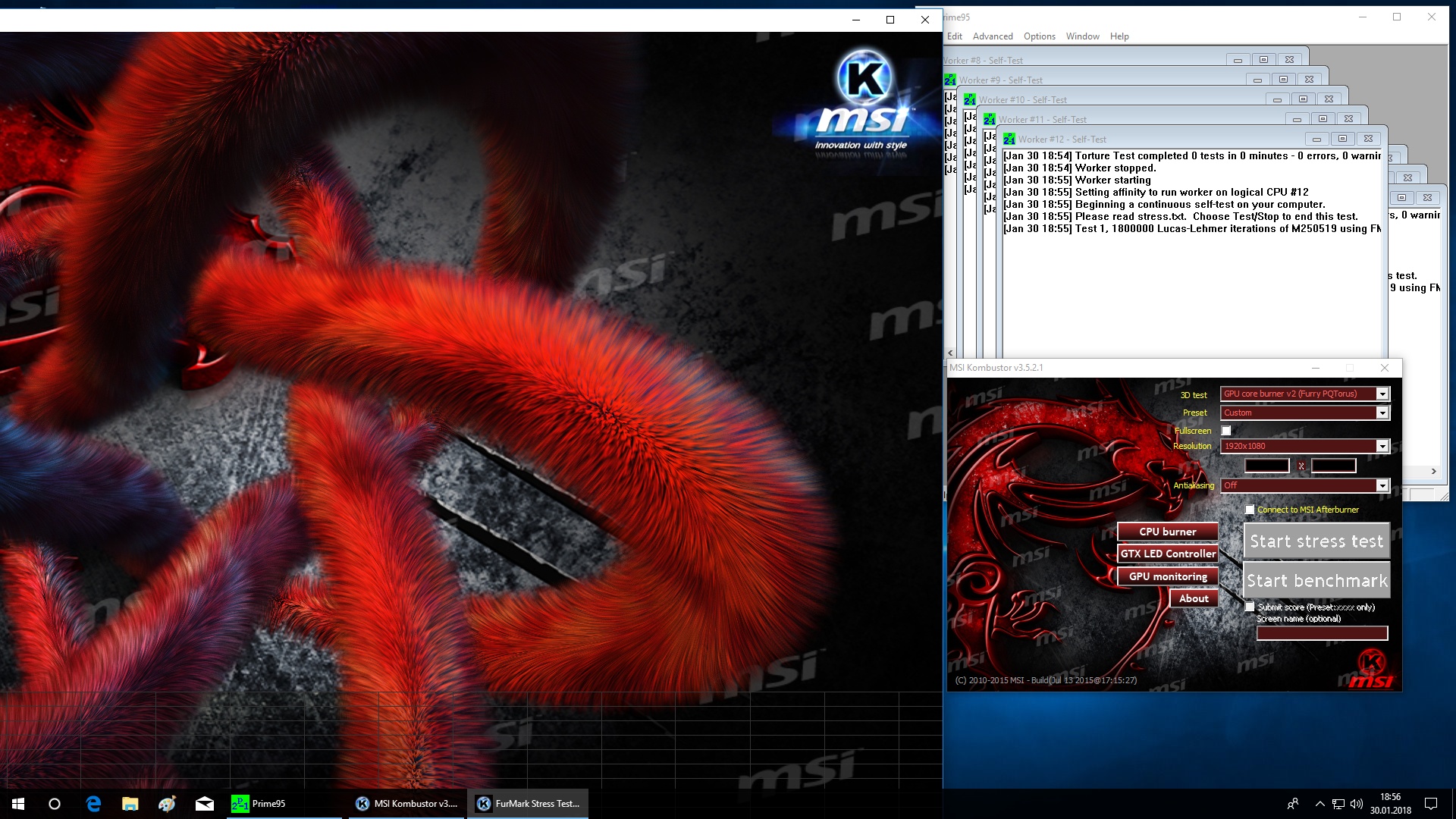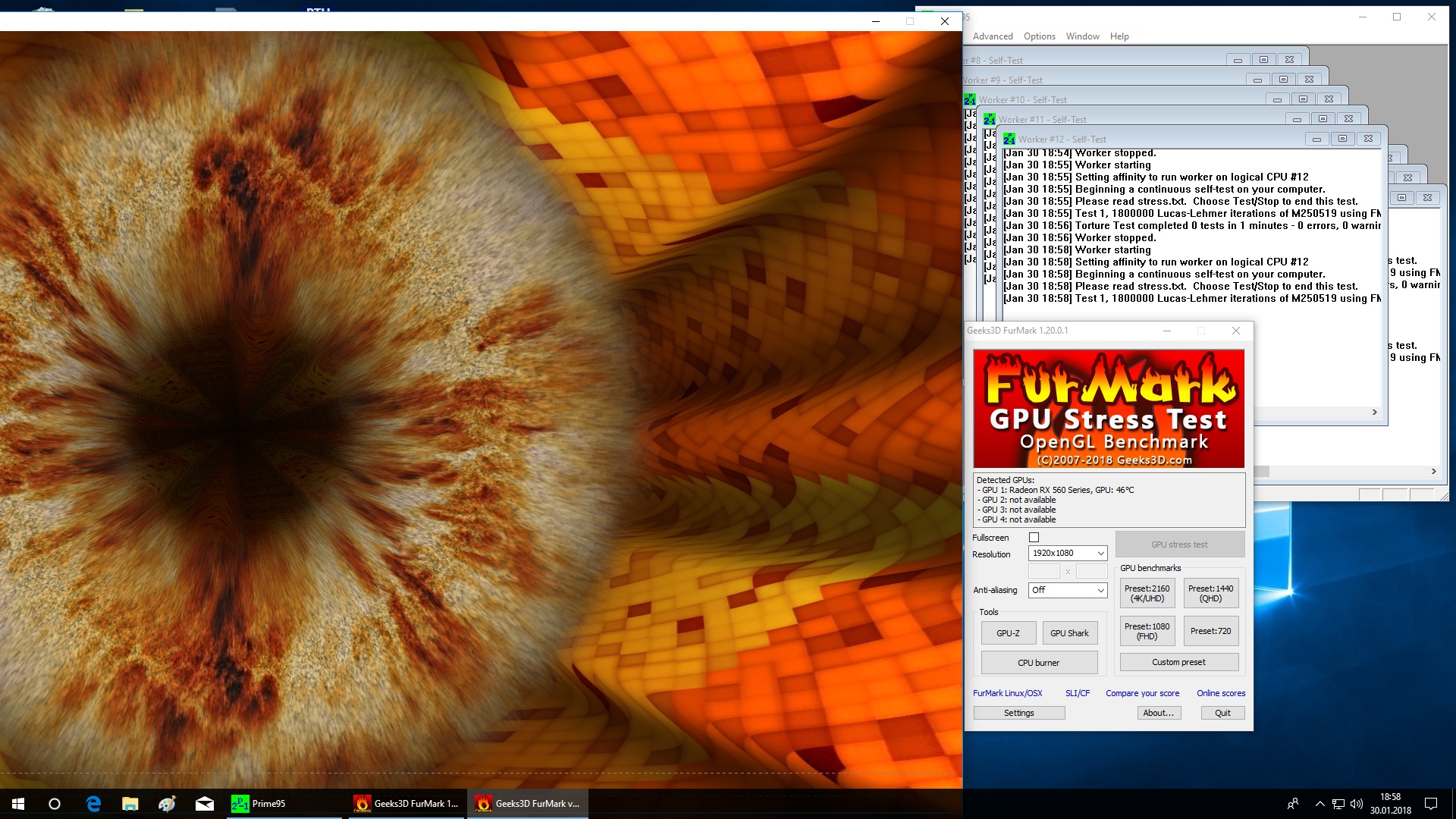How to Stress-Test CPUs and PCs (Like We Do)
Is it getting hot in here?
System: Prime95 & GPU
For our combined stress tests, we use Prime95 (with AVX or SSE, as well as Small FFTs) with MSI Kombustor and FurMark, our suite's two most challenging graphics workloads. For these combinations to produce their full load, Prime95 needs to be started first and set to low priority via Windows' Task Manager. All threads that are started during the stress test automatically inherit this priority.
MSI Kombustor and FurMark generate a processor load of just 1% to 5%. However, Prime95 at its default settings would still slow these applications down so much that their GPU loads would decrease significantly. We also start both GPU stress tests in windowed mode in order to not push Prime95 into the background too much, while making sure that the GPU workload's window is active. With all of this taken care of, we know our hardware is truly maxed out.
The warnings on page 1 apply again here, but even more urgently since we're being extra hard on our components. Be diligent in monitoring all relevant health parameters: Any misstep has destructive potential.
Prime95 With AVX & Small FFTs + MSI Kombustor GPU Core Burner
First, we combine the CPU and GPU stress tests that generated the highest loads during our previous measurements. It’s not surprising that this gets us the second-highest result for system stress testing. The highest result, achieved by using FurMark, is so close that we deem it within a margin of measurement error.
The loads that this combination generates would never be applied by a real-world application. In other words, they aren't realistic in any way. However, enthusiasts interested in examining the limits of their power supplies or cooling subsystems can do so with these two pieces of software.
| Header Cell - Column 0 | CPU Package(PECI) | Core Average | SensorSocket | GPUDiode | CPU(Watts) | GPU(Watts) | System (Watts) |
|---|---|---|---|---|---|---|---|
| Measurement | 85°C | 85°C | 104°C | 64°C | 168W | 101W | 355W |
| Compared to Maximum | 100% | 100% | 100% | 100% | 99.4% | 100% | 99.4% |
| Assessment | Very high package temperatureExtremely high socket temperatureSomewhat low memory temperatureMaximum GPU power consumptionVery high CPU and system power consumption | ||||||
| Use for | Extreme overall system loadCooling test for high-performance coolersTest power supply unit’s limitPerfect choice for finding cooling and power consumption limits |
Prime95 With SSE & Small FFTs + MSI Kombustor GPU Core Burner
The SSE code path is less intensive, making it safer for the CPU and other components involved in the stress test. However, it still generates enough load to push the system hard.
| Header Cell - Column 0 | CPU Package(PECI) | Core Average | SensorSocket | GPUDiode | CPU(Watts) | GPU(Watts) | System (Watts) |
|---|---|---|---|---|---|---|---|
| Measurement | 73°C | 72°C | 77°C | 64°C | 125W | 101W | 284W |
| Compared to Maximum | 85.9% | 84.7% | 74.0% | 100% | 74.0% | 100% | 79.6% |
| Assessment | High package temperatureMedium socket temperatureSomewhat low memory temperatureMaximum GPU power consumptionHigher CPU and system power consumption | ||||||
| Use for | High overall system loadCooling test for mid-level coolers |
Prime95 With AVX & Small FFTs + FurMark
Once again, we generate an extremely high load. This time, though, it's the greatest level of stress we measured. Those using this combination should heed our warnings about possible system damage, though ideally your worst-case situation would be an automatic shutdown. Most motherboards don’t include any thermal protection for their voltage converters. Rather, these are reserved for high-end platforms (and they aren’t a given there, either).
Get Tom's Hardware's best news and in-depth reviews, straight to your inbox.
| Header Cell - Column 0 | CPU Package(PECI) | Core Average | SensorSocket | GPUDiode | CPU(Watt) | GPU(Watt) | System (Watt) |
|---|---|---|---|---|---|---|---|
| Measurement | 85°C | 85°C | 104°C | 64°C | 169W | 101W | 357W |
| Compared to Maximum | 100% | 100% | 100% | 100% | 100% | 100% | 100% |
| Assessment | Very high package temperatureExtremely high socket temperatureSomewhat low memory temperatureMaximum GPU power consumptionVery high CPU and system power consumption | ||||||
| Use for | Extreme overall system loadCooling test for high-performance coolersTest power supply unit’s limitPerfect choice for finding cooling and power consumption limits |
MORE: Best CPUs For Gaming
MORE: Intel and AMD Processor Benchmark Hierarchy Comparisons
MORE: All CPUs Content
Current page: System: Prime95 & GPU
Prev Page CPU Only: Measuring Temperatures With Different Stress Tests Next Page System: MSI Kombustor & OCCT
Igor Wallossek wrote a wide variety of hardware articles for Tom's Hardware, with a strong focus on technical analysis and in-depth reviews. His contributions have spanned a broad spectrum of PC components, including GPUs, CPUs, workstations, and PC builds. His insightful articles provide readers with detailed knowledge to make informed decisions in the ever-evolving tech landscape
-
WINTERLORD Is this like a fancy water cooler im guessing? what about a typical AIO cooler. In fact i have a skyth fuma but may save up to get some kind of AIO water cooling been tryin to find decent reviews on decent water coolers both cheap and if needed high end. not no alpha cooler though lolReply
Alphacool Eisblock XPX ($73.99 On Newegg)
Alphacool Eiszeit 2000 Chiller -
FormatC This is a high-end compressor cooler for up to 1500 watts heat input. It's a modified version from industry and mostly used to cool the head of powerful laser cutters. Why I'm using this one? To show, which program is able to do it right. If you have additionally limitations from coolers, thermal throttling and other funny things, you will never see the exact difference. I can keep a constant water temperature of 20°C to make all the test results comparable. ;)Reply -
Th_Redman What did you guys put on the hotdog after testing? A little mustard, ketchup, relish, sauerkraut...? LOL.Reply -
aquielisunari I use Aida, Prime 26.6, Superposition, UserBenchmark, MSI's kombustor and I no longer use Heaven. I may be forgetting a couple. But something has always felt a little off. I finally see what it was. My build was missing a hotdog and its bun. I always do love learning from the pros. I placed it on a piece of parchment and instantly I notice a difference.Reply
I routinely check temperatures, loads and other info from my system. I also stress test with different CPU and GPU benchmark/stress test software. Thanks for the info. Page bookmarked. -
CompuTronix As the author of the Intel Temperature Guide - http://www.tomshardware.com/forum/id-1800828/intel-temperature-guide.html - I can fully appreciate how much work went into creating this outstanding article, which has been sorely needed!Reply
Since most users test their rigs without a sense of scale for power and temperature, they can't compare apples to apples, especially when combined with major variables such as differences in ambient temperature, hardware configurations and software utilities. This article provides a perspective and some excellent comparisons.
The Intel Temperature Guide differs in its approach toward the topic of processor Core temperatures and cooling with respect to Intel's TDP specifications, and distinguishes between steady workloads for thermal testing versus fluctuating workloads for stability testing. Nevertheless, our results are very similar.
However, since Intel validates their thermal specifications at a steady 100% TDP, it's most appropriate to select utilities that don't overload or underload the CPU. The only utilities I've ever found that come as close as possible to 100% TDP are Prime95 v26.6 Small FFT's as a steady workload for thermal testing, and Asus RealBench as a fluctuating workload for stability testing.
Although the topic of Prime95 (with and without AVX) was covered, I would like to have seen RealBench included in your test suite,since it's widely accepted as an excellent utility for testing overall system stability, and uses a realistic AVX workload.
Otherwise, great work! I was very pleased to read this article!
CT :sol: -
cangelini Reply20741319 said:As the author of the Intel Temperature Guide - http://www.tomshardware.com/forum/id-1800828/intel-temperature-guide.html - I can fully appreciate how much work went into creating this outstanding article, which has been sorely needed!
Since most users test their rigs without a sense of scale for power and temperature, they can't compare apples to apples, especially when combined with major variables such as differences in ambient temperature, hardware configurations and software utilities. This article provides some excellent comparisons.
The Intel Temperature Guide differs in its approach toward the topic of processor Core temperatures and cooling with respect to Intel's TDP specifications, and distinguishes between steady workloads for thermal testing versus fluctuating workloads for stability testing. Nevertheless, our results are very similar.
However, since Intel validates their thermal specifications at a steady 100% TDP, it's most appropriate to select utilities that don't overload or underload the CPU. The only utilities I've ever found that come as close as possible to 100% TDP are Prime95 v26.6 Small FFT's for thermal testing, which is a steady workload, and Asus RealBench for stability testing, which is a fluctuating workload.
Although the topic of Prime95 (with and without AVX) was covered, I would like to have seen RealBench included in your test suite, as it's widely accepted as an excellent utility for testing overall system stability, and uses a realistic AVX workload.
Otherwise, great work! I was very pleased to read this article!
CT :sol:
That's an awesome resource, CT! -
WyomingKnott Reply20740696 said:What did you guys put on the hotdog after testing? A little mustard, ketchup, relish, sauerkraut...? LOL.
Thermal compound. Why not? People have used condiments between their CPUs and their coolers. -
FormatC Step 1 - Collect all what I need:Reply
Step 2 - Start the oven
Step 3 - Enjoy!
The benchmark:
The complete review was so funny, but it was never translated :(

